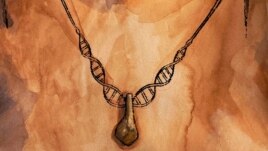14 May 2023
A new way of pulling DNA from soft materials such as bones, teeth and tusks makes it easier for scientists to find out about objects made by ancient people.
As a result, researchers are working to learn about those who made and wore objects taken from a cave in what is now far eastern Russia.
Elena Essel is with the Max Planck Institute for Evolutionary Anthropology in Germany. She is the lead writer of a study recently published in the journal Nature. She and her team say they now know a lot about jewelry made 20,000 years ago -- and who wore it.

An artistic interpretation of an ancient pendant made with an elk tooth, found at the Denisova Cave in southern Siberia, with dark DNA-shaped cordage is seen in this undated handout image. (Myrthe Lucas/Handout via REUTERS)
Essel is a molecular biologist. She called the old items, such as an animal's tooth with a hole punched through it, "extremely fascinating."
The scientists say a Stone Age woman wore the pendant. The piece of jewelry was carefully recovered from the Denisova Cave in Siberia.
The new way of looking at DNA permits researchers to link one item, such as a piece of jewelry, to one person. The researchers only know very basic things about the person beyond their DNA. The DNA comes from sweat, bodily fluids or skin cells.
They study the DNA at a lab in Leipzig, Germany. Scientists place the item into a liquid that "washes" out the DNA. They can then look at the liquid and find out about the people who once held the item.
In this case, they say the pendant belonged to a woman who lived between 19,000 and 25,000 years ago. They could not say if the woman made it or only wore it.
Essel said the new DNA science permits her to "travel back and have a glance into these people's lives."
Essel said holding the item in her hand transported her back in time and she could imagine the person who made it.
She thought of a lot of questions, such as: "Who was the person who made it? Was this tool passed down from one generation to the next, from a mother to a daughter or from a father to a son?"
Essel added, "That we can start addressing these questions using genetic tools is still absolutely incredible to me."
I'm Dan Friedell.
Dan Friedell adapted this story for Learning English based on a report by Reuters.
___________________________________________________________________
Words in This Story
journal –n. a magazine that reports items of special interest to small group of people
jewelry –n. decorative objects people wear on their body
fascinating –adj. very interesting
pendant –n. a piece of jewelry worn around the neck
glance –v. to look quickly at something
incredible –adj. hard to believe